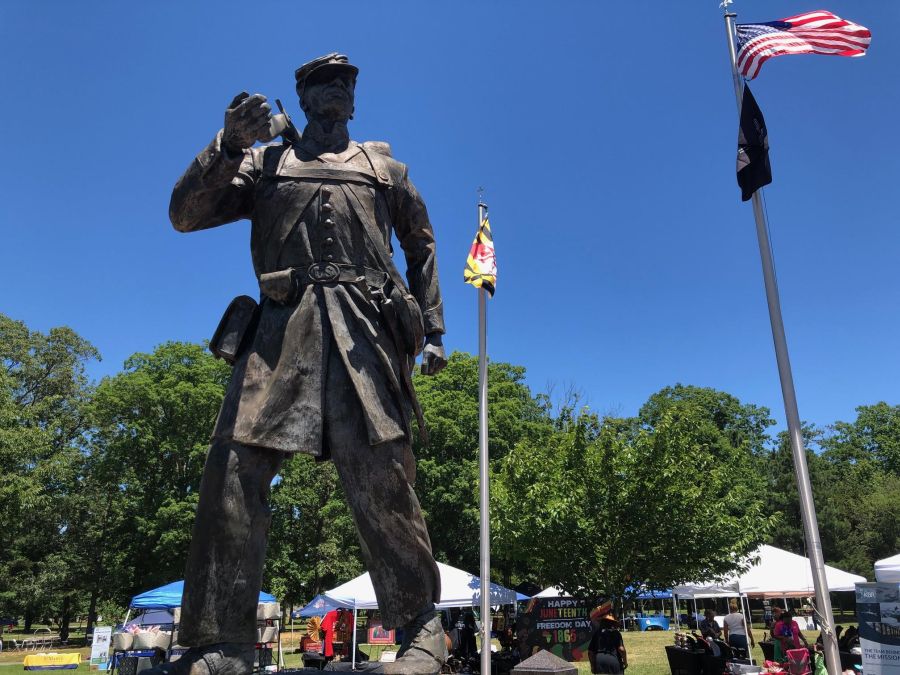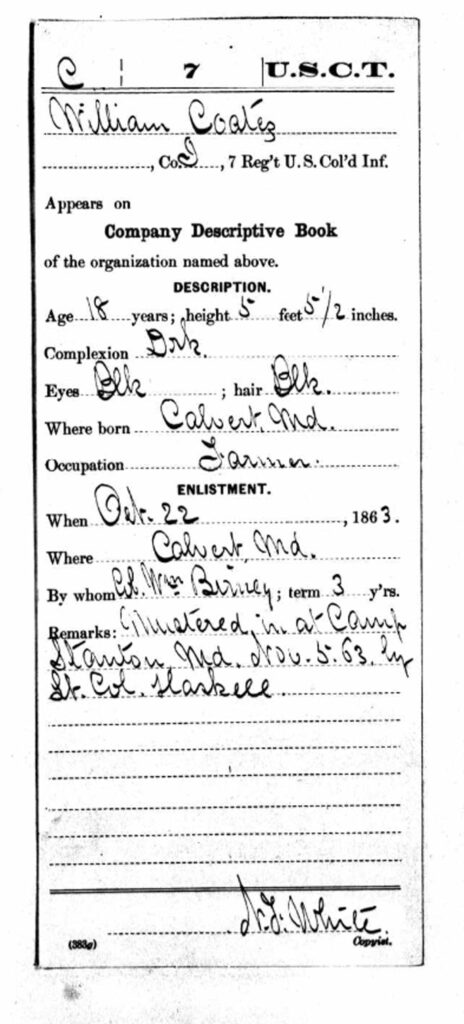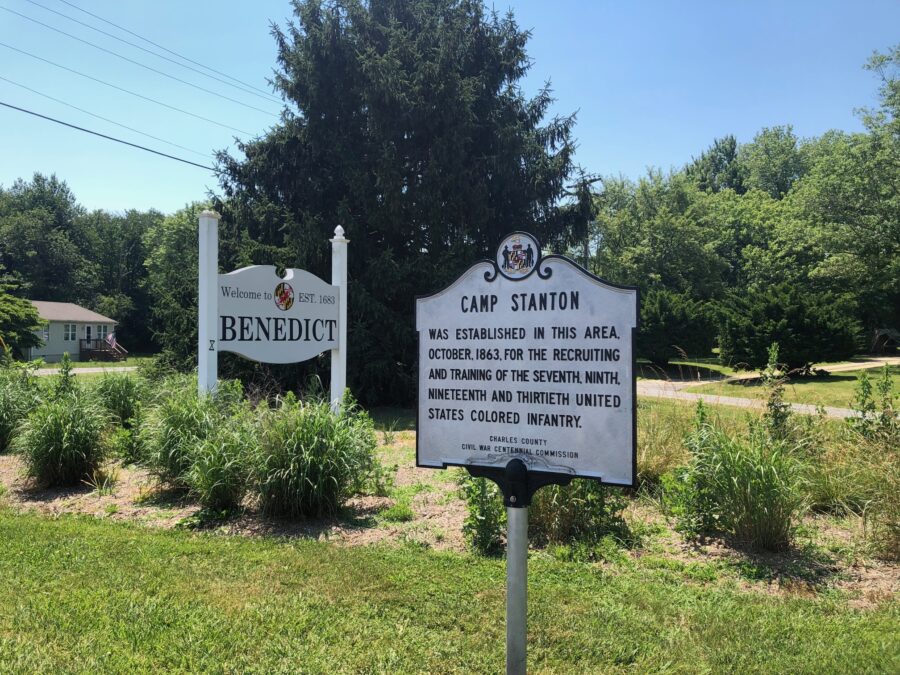Al’s Juneteenth Special Tea: Camp Stanton and the Colored Troops Who Helped Free Slaves

The United States Colored Troops Memorial Statue, Lexington Park, Maryland, photographed at the t 2024 Juneteenth Celebration.
Welcome in for a special Al’s Afternoon Tea commemorating Juneteenth — and some of the soldiers who made it possible.
The tiny town of Benedict nestles along the scenic Patuxent River in southern Maryland, an idyllic blend of waterfront homes and bountiful farmland. The kind of place where the best (perhaps even the only) restaurant is found down a gravel road — a bar and seafood joint that from the outside looks like a mechanic’s garage and inside you can find a crusty Marine spinning stories of his tours in Vietnam. You would be hard pressed to wander through Benedict and think, “Here, history was made. Here, in these fields, soldiers learned to fight to liberate a people.” And not just any soldiers. Free black men, and even slaves.
In the autumn and winter of 1863-64, Benedict was home to Camp Stanton. And today, on Juneteeth, we want to tell the story of those who trained there and helped bring about the end of slavery.
Recruiting and Training Fighters
“There is … in my judgment, a military necessity, in the State of Maryland … for enlisting into the forces all persons capable of bearing arms on the Union side without regard to color, and whether they be free or not.” –Secretary of War Edmond Stanton to President Abraham Lincoln.
In 1863, at Stanton’s urging, President Abraham Lincoln decided to recruit colored troops to fight in the Union Army. While Maryland stayed in the Union, its southernmost counties were as Confederate as neighboring Virginia. Lincoln figured southern Maryland, the heart of the slave-holding region, would be a perfect place to find and train soldiers from among freed slaves and those still seeking freedom.
The camp would be named Camp Stanton, after the Secretary of War.
Opening in October 1863, Camp Stanton saw the enlistment, equipping, and training of the 7th, 9th, 19th and 30th Colored Infantries of the U.S. Colored Troops (USCT). While Benedict today is a beautiful area, the white commander of the 9th Infantry was unimpressed by it. Col. Sam Armstrong declared Benedict a “horrible hole, a rendezvous for blockade runners, deserters, and such trash; good for nothing but oysters.”
Naturally, the Confederacy did not react well to the news the boys in gray would be facing black soldiers. So a directive was given: Captured black Union soldiers would be enslaved.
The formation of the USCT was greeted with trepidation in some quarters in the North as well. Before the Civil War, black people were not allowed to have guns. But with the formation of these infantries, they were armed in the service of the U.S. government.
Some 8,700 soldiers trained at Camp Stanton in the six months it existed. Unfortunately, its location along the Patuxent was a breeding ground for sickness and disease, and during the harsh winter, many recruits passed away. The decision was made to dismantle and burn the camp in March 1864.
However, for those six months, Camp Stanton played a pivotal role in bringing freedom to the lower Chesapeake Bay region, and soldiers from those regiments would serve admirably for the rest of the war.
Slaves Leave a Plantation to Join the Fight … with Their Owner’s Blessing
Across the Patuxent in Calvert County, two young men, William H. Coates and William B. Jones, were determined to enlist. There was just one wrinkle: They were both slaves, working on a farm owned by a man named George Peterson. However, Peterson gave the two permission, and they crossed the river to join the 7th Infantry. Since Lincoln’s Emancipation Proclamation excluded Maryland, slavery was technically still legal in the state and Peterson received $300 to compensate him for the lost labor.

The enlistment papers for William Coates (ancestry.com)
Participants and Witnesses to the Fall of the Confederacy
“What cared we for the color or race of those men who brought relief to us. We saw courage and determination in their coal-black faces.” –Captain Luman Tenney, 2nd Ohio Cavalry
After participating in campaigns in Virginia, South Carolina, and Florida, the 7th Infantry, in which Coates was a private and Jones was a corporal, took part in the battle for the Confederate capital of Richmond, as the Union squeezed the life out of the rebel army. The fight would move toward a small town called Appomattox, as Gen. Robert E. Lee’s battered army tried to make its escape. But U.S. Colored Troops blocked their way.
Appomattox would be the South’s last major stand. Some 5,000 colored troops, including those of the 7th Infantry, were on hand to finish the Confederates off. They were still fighting on the the morning of April 9, 1864. That day, recognizing the situation as hopeless and hoping to avoid unnecessary loss of life, General Lee agreed to meet Union Commanding General Ulysses S. Grant at Appomattox Courthouse to offer his unconditional surrender.
The Civil War was over.
Can you imagine being one of the USCT soldiers who started the war as slaves being present at Appomattox when slavery in America met its end?
Afterward, the 7th Infantry headed to Texas. There, on June 19, 1865, Union General Gordon Granger spread the word of freedom.
The people of Texas are informed that in accordance with a Proclamation from the Executive of the United States, all slaves are free. This involves an absolute equality of rights and rights of property between former masters and slaves, and the connection heretofore existing between them becomes that between employer and hired laborer.
June 19th. Freedom Day.
Juneteenth.
‘Caring for Those Who Shall Have Borne the Battle’: The Story of Dr. Alexander Augusta
“With malice toward none, with charity for all, with firmness in the right as God gives us to see the right, let us strive on to finish the work we are in to bind up the nation’s wounds, to care for him who shall have borne the battle and for his widow and his orphan — to do all which may achieve and cherish a just and lasting peace among ourselves and with all nations.” –President Abraham Lincoln, 2nd Inaugural Address.
Alexander Augusta of Norfolk, Virginia had wanted to be a doctor for as long as he could remember. And despite the obstacles presented by the color of his skin, Augusta eventually earned his medical license. By the start of the Civil War he was operating a successful practice in Canada, far, far away from the fighting. However, when Lincoln issued the Emancipation Proclamation, he felt the call to serve, saying, “The coloured people have a duty to perform at this present time.” He wrote to Lincoln, requesting “an appointment as surgeon to some of the coloured regiments, or as a physician to some of the depots of freedmen.”
Please Support The Stream: Equipping Christians to Think Clearly About the Political, Economic, and Moral Issues of Our Day.
However, after arriving in the United States, Augusta received a letter rescinding the offer because he was a “person of color.” Also, because his years in Canada technically made him a British citizen, his service would violate Britain’s neutrality in the war.
Undaunted, Augusta wrote Lincoln and the U.S. Army Medical Board, declaring, “I have come nearly a thousand miles at great expense and sacrifice, hoping to be of some use to the country and to my race at this eventful period.” As a result, the medical board reversed its decision. Augusta was given the rank of major and assigned to Camp Stanton, becoming the first black surgeon in U.S. Army history.
In fact for a time, Dr. Alexander Augusta was Camp Stanton’s chief surgeon — meaning he outranked several white doctors, all but one of whom protested. Fearful of losing the doctors when so few were available for the war effort, the military decided to transfer Augusta. He was put in charge of a new hospital for black people at the site of Camp Barker in Washington, D.C., becoming the first black hospital chief in the United States.
When an Army paymaster refused to pay him more than the standard wage for a black soldier ($7 a month, rather than the $169 monthly salary his rank and position entailed), Augusta fought back — and won.
Augusta would be recognized for his leadership. According to the National Park Service, “he was awarded an honorary brevet rank of lieutenant colonel. This prestigious distinction made Augusta the highest-ranking black officer in the U.S. Military at that time.” He’d also become one of the first black people invited to the White House, attending a reception thrown by Abraham and Mary Todd Lincoln with his assistant, Dr. Anderson Abbott. (Tragically, Abbott would be one of the doctors at Lincoln’s bedside when he died from injuries caused by an assassin’s bullet.)
The war didn’t bring an end to Dr. Augusta’s historic exploits. He later taught at Howard University, becoming America’s first black medical professor.
A Thank-You This Juneteenth
Roughly 179,000 black men served in the United States Colored Troops, comprising about 10% of the Union forces. Nearly 40,000 died (three-fourths of them from disease). Another 19,000 served in the Navy. The USCT took part in 39 major Civil War battles and more than 400 smaller ones.
Sixteen black soldiers were awarded the Medal of Honor. Lincoln said of colored troops that joined the Union fight, “We would not have won the war without them.”
Without them, there’d be no Juneteenth.
On this holiday, may we remember and salute the U.S. Colored Troops. And whenever we pass through Benedict and the other towns that hosted these brave men, may we give thanks for their service and sacrifice.

Al Perrotta is The Stream’s Washington bureau chief, coauthor with John Zmirak of The Politically Incorrect Guide to Immigration, and coauthor of the counterterrorism memoir Hostile Intent: Protecting Yourself Against Terrorism.


